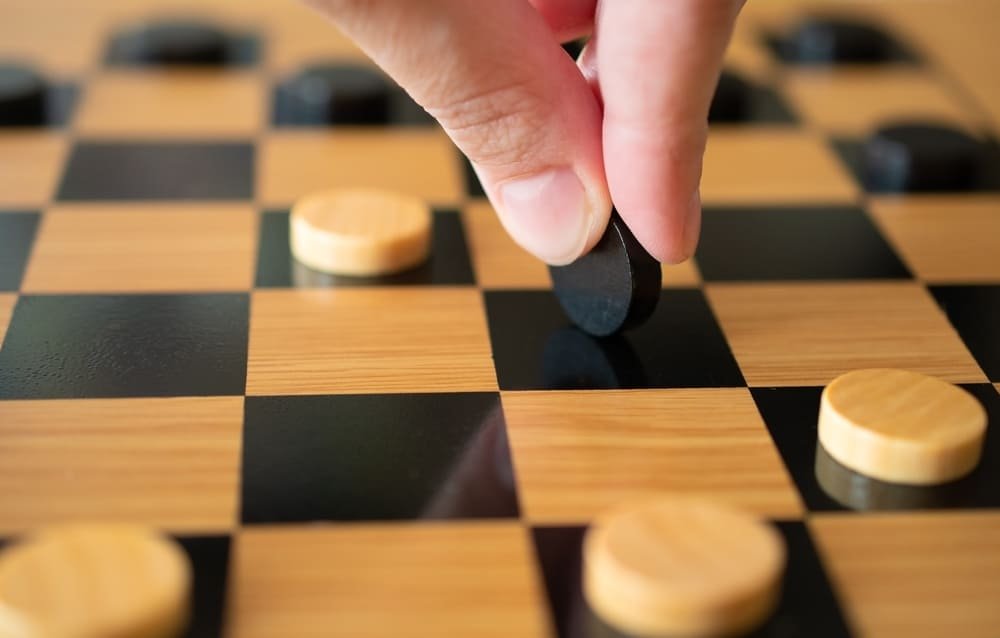Last Updated on January 7, 2024 by Gamesver Team and JC Franco

When I first saw a Checkers board, I did not know what to expect. However, I now know that it is a fun game that is relatively easy to learn. I was first introduced to Checkers when I was a child, and luckily I had some pretty good tutors to get me started.
With that being said, I’m aware that not everyone had the same opportunities. So, if you have heard of the benefits of Checkers and want to learn how to play, or even if you want to teach your kids (so that they can enjoy the benefits too), you first need to know the rules.
SUMMARY OF THE RULES OF CHECKERS
OBJECTIVE:
- The game’s main objective is to capture every opponent’s piece.
MOVING:
- Moves are always diagonal, towards the opponent, and via dark squares only.
- You can only jump one square at a time unless capturing a piece, in which case two squares will be jumped.
- You cannot jump over two consecutively positioned pieces.
- Players will alternate turns to move.
CAPTURING:
- You may only capture one piece per jump.
- If a single capture is available, it must be taken.
- If multiple captures are available, the player can decide which one to take, but still, a capture must be taken.
- Captured pieces are eliminated from the board.
CROWNING A KING:
- A piece reaching the furthest row from the player in control is crowned king by placing on a captured piece on top of that piece, doubling its height.
- Pieces crowned king can move backward and forward, but only in a diagonal direction.
Just reading through the rules makes Checkers seem a whole lot simpler than it looks, doesn’t it? If you want to teach your kids how to play, keep in mind that kids typically above the age of 4 years old tend to learn the rules of play quite quickly. Younger kids tend to lack the concentration and patience skills required. Of course, it is fairly simple for adults to learn how to play Checkers too.
*If you’re more of a visual learner, I suggest you take a quick look at the following video from our friends at “Triple S Games”.
Read on below to discover the main objective of Checkers and how to play, step by step.
The Objective of Checkers – What’s the Point of a Game of Checkers?
In order to win at a game of Checkers, and keep to the rules at the same time, you need to understand what the objective of the game is. In a game of Checkers, both opponents aim to capture every opponent’s piece, while moving their pieces towards the other player’s side of the board.
Players can move quickly to their opponent’s side of the board by jumping diagonally over opponent’s pieces and removing them from the board as “captured” pieces. There are various strategies that players can use to ensure that they win every time – or at least most of the time! You can find some of these strategies further on.
For some people, the objective of playing Checkers is the various health benefits, which include improvements in the following areas: memory recall, judgment calls, problem-solving, concentration, confidence, and decision making, to name a few.
How to Play Checkers & Stick to the Rules
Now that you have a basic understanding of the game, you need to know how to get started. What’s great about a game of Checkers is that you can really play alone the very first time and when you practice. However, it’s a good idea to have an opponent if you want to truly enjoy the game. Let’s take a closer look at how to play Checkers and how the rules apply.

1. Decide which color each player will have.
First, you need to decide which color each player will have. There are black and white pieces to choose from. The player with the black pieces must start the game.
2. Set the board up with all the pieces.
Players sit on opposite sides of the board, across from each other. To ensure that the board is correctly positioned, make sure that there is a light square on the corner of the board on your right-hand side.
Place pieces onto the board, in the dark squares only. Remember that pieces can only move diagonally forward on the dark squares. Once all of the pieces are on the board, there should be two rows of open squares in the middle of the board. These squares are left open until the pieces are moved.
3. The player with the black pieces starts the game.
The player with the black pieces starts the game by moving any piece diagonally towards the opponent. This can only be done by moving along the dark squares.
4. Capturing an opponent’s piece.
If a player’s piece finally lands diagonally across from an opponent’s piece, in the very next square, and there is an open space behind it; the player can hop over the piece, occupy the open space diagonally behind it, and claim the piece (by removing it from the board).
5. Players that have an opportunity to jump an opponent’s piece must make the move.

Players that have an opportunity to jump an opponent’s piece must make the move, instead of choosing to move another piece. The only time this does not apply is when there is more than one opportunity to jump a piece when a player’s turn comes around. When this happens, players can only decide between these possible jumps instead of moving a new piece or avoiding the jump.
6. Players can hop over only one piece in a move unless the landing position immediately provides another jump opportunity.
Players can hop over only one piece in a move, but if the landing position immediately provides another jump opportunity, the player must take it and keep on making jumps until captures are no longer possible. If this keeps a player jumping several times and capturing several of the opponent’s pieces, this is considered highly valuable (in fact, this is living the Checkers dream).
7. When a player’s piece reaches the last row on the opponent’s side of the board, they can use one of their captured pieces to crown the piece as king.
Now the king can move backward and forward, but still only diagonally. Because of this, kings are valued as they provide more scope for capturing the opponent’s pieces. There is no limit set for the number of crowned kings a player can have. A king can only capture one piece per jump but can capture more than one piece if the landing space provides a new opportunity for a capture. While doing so, the king can move both backward and forward in one sequence of jumps.
8. When a player has captured all the opponent’s pieces, he/she wins the game.
Of course, this is the main objective of the game, and in my experience, it is a cause for much celebration. Alternatively, you can play in a way that ensures all the opponent’s pieces have nowhere to move.
Tips and Tricks to Use Checkers Rules of Play to Your Advantage

There’s a reason that the Checkers (or Chess) board is hauled out at most family gatherings and child-friendly events. This is because Checkers is a competitive game that is time-consuming, simple to understand, and undeniably fun. It means many hours of entertainment where participants are very unlikely to get bored or abandon the game.
Of course, you do not just want to win once or twice, though. You want to win all the time – at least I do! Some Checkers players have nailed a few simple strategies and techniques that help to satisfy this particular desire to win. Below are a few pointers that you can use if you want to ensure that your ability to win Checkers is increased.
- Keep your back row of pieces occupied as long as possible. This stops the opponent from being able to crown any pieces.
- Move your pieces in batches so as to protect each piece as you move.
- Avoid moving all of your pieces to the middle of the board as moves are more limited after this point. There’s not much scope of diagonal movement from the center of the board.
- Focus on creating block situations in order to lure your opponent into playing their back row of pieces. This is particularly useful if your opponent is savvy to the idea of keeping their back row strong.
- Be strategic about losing pieces if you can afford to. If you are in the lead, there could be times where you could allow one of your pieces to be captured. This is only recommended if doing so will lead to you capturing more of your opponent’s pieces or put in an advantageous position.
- Ensure that your king pieces are surrounded by other pieces as much as possible. This is to ensure that the king is never exposed to possible capture.
- Play or practice Checkers as often as possible in order to become familiar with the game and become more comfortable with strategic play.
Last Word
See, learning how to play Checkers is actually a lot simpler than most people think it is! Now that you fully understand the rules of Checkers and how to play, it’s time to get to work practicing. You can find affordable Checkers boards online, and you certainly won’t struggle to find opponents to play against, especially if you have kids, a partner, or friends nearby.

